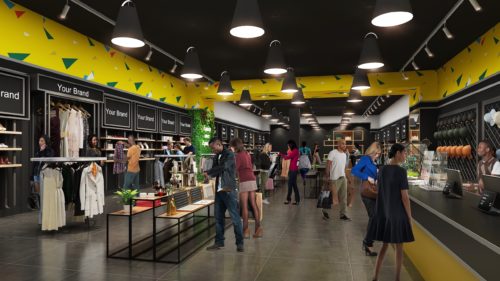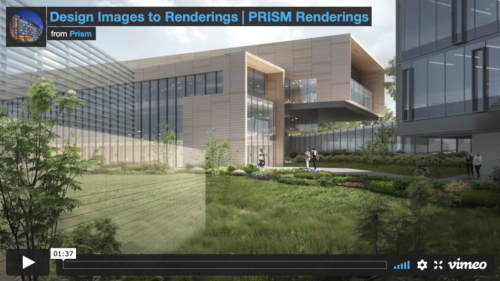“The best investment you can make is in yourself.” We agree 100% with Warren Buffett on this! Houston Commercial Real Estate Millennial Misses (CREMM) is hosting a series on branding yourself. Deborah Gross is attending and will be sharing some highlights in the next newsletter.
Drone photography has come a long way since the first known aerial photo was taken in 1858. A camera was tethered to a hot air balloon 262 feet in the air to get a bird’s eye view of a neighborhood outside of Paris. Since then, photographers have been capturing increasingly advanced images of our landscape as seen from above. This perspective gives the viewer a better sense of spatial relationships of large areas that couldn’t possibly be perceived on the ground. Now, with renderings superimposed onto aerial drone images, it is possible to get a true sense of how a planned building project will relate to its surroundings. PRISM has been producing such images for over two years. Our clients have realized several benefits:
Whenever traveling, I endeavor to visit the completed projects we have worked on. It’s such a rewarding experience to see the buildings and spaces transform from the photo-realistic visuals we created for our clients to a realistic masterpiece. During my recent family vacation in Denver, we stayed downtown to experience the vibrant urban life of the Mile-High City. I was so excited to find out we had worked on five projects located within 10 miles and decided to turn my last day in the city into a field trip. Out of the three projects I visited, the most exciting one is EVIVA, located one block from the Denver Art Museum, designed by one of my favorite architects, Daniel Libeskind. This luxury apartment building commands a chic yet industrial aesthetic style. The best part of the building is the magnificent view from the rooftop resort-style pool area and outdoor deck. It overlooks the striking massing of the museum, Denver skyline, and Rocky Mountains in the distance. Being a part of our client's grand vision for their projects is the ultimate gratification we gain from our work. I can't wait to visit more projects during future trips.
The median price of a single-family home in Houston hit a record high of $304,000 in May 2021. Considering that the median income of all Houston’s neighborhoods is $44,124, this makes home ownership infeasible for many. And in Greater OST/South Union, where the median income plummets to $27,373, owning a home is only a dream for many residents. The Agape Homes Community Development Corporation (CDC), created by Agape Development Ministries because they saw their neighbors being displaced due to gentrification, is helping make this dream a reality. The non-profit plans to build 75 community-designed, affordable, energy-efficient homes. It is helping families below 80% AMI by offering to sell the homes at their cost. Local architect Kim Schaeffer led a community design charrette that shaped the final floor plans produced by W Partnership; all the homes feature exteriors that fit with the historical architecture of the neighborhood. Newmark Homes also provided insight into the design and ongoing support for the development. PRISM worked with the team to generate renderings critical for the development’s success; renderings were used for Agape to obtain a land grant from Midtown Redevelopment Authority, purchase adjacent lots, market to future homeowners and donors, and aid new homeowners with home completion. Agape Homes is building new homes on empty lots in the neighborhood south of the University of Houston called OST/South Union. The intent is to cause zero displacements while increasing the owner occupancy rate in the neighborhood. Homes will range in size from 839 s.f. to 1,453 s.f., to fit the needs of buyers while staying affordable. All homes were designed through a community charrette with the input of neighborhood families. In addition to working in OST/South Union, almost all of the full-time staff from the Agape housing, ministry, and social enterprise teams live in the community as well. This practice allows the organization to plug in, share and experience the good, the hard, and the challenges of daily life in the neighborhood. It also helps to build closer relationships and be a resource and partner for the benefit of the whole area.
It would seem as though it wasn’t until last summer’s unrest that prioritizing support for Black-owned businesses became a popular trend for the nation at large. However, that is simply not the case, especially for Houston-based BLCK Market. Jeremy Malone (also known as J.O.) founded BLCK Market with the mission to provide a safe place for small businesses and entrepreneurs. The BLCK Market is curated to the Black American experience and provides an opportunity to showcase quality brands and products to tens of thousands of consumers. Their vision is to bring value back to the community through financial literacy, wellness, and creativity. BLCK Market, considered to be Houston’s largest gathering of Black-owned businesses, started out holding in-person events every first Friday and second Saturday. When the COVID-19 pandemic began, it pivoted to an online platform out of necessity. Not only did this e-commerce marketplace keep the BLCK Market name alive, but it also kept other Black brands open for business. Today, BLCK Market has begun holding its in-person events again and it will continue growing its digital platform. On the horizon are plans to open its first retail store to further this important mission. BLCK Market Retail will be opening Labor Day weekend and will be located at the Pearland Town Center, only 15 minutes south of downtown Houston. Pearland currently ranks #6 on 24/7 Tempo’s list of fastest-growing American cities according to USA Today. PRISM was honored to produce the rendering used to market the storefront debut. If you’d like to be one of the first 25 vendors to be featured at the Flagship store, visit BLCK Retail to learn more. The great news is all vendors keep 100% of their sales at BLCK Market Retail!
Her title may be Director of Operations, but we consider Sarah Amos our own Wizard of Oz. She works behind the scenes to keep everything moving forward with our clients and their projects. As the mom of four, it’s no wonder she is so good at keeping us all on track! Happiest Birthday to you Sarah!
The East End Maker Hub epitomizes Houston’s can-do attitude. A public-private partnership made the renovation of this 300,000 s.f. facility possible. This innovation/manufacturing center aims to create 1,000 new companies in five years. PRISM was honored to attend the opening festivities!
3D models are powerful tools architects and designers use to communicate space. The layout of the space, lighting, and the finishes within it can entirely and distinctly differentiate two spaces of the same size. Home design shows are popularizing 3D models, using them to guide homeowners through the design process to their dream kitchen, master bath, man cave – the list goes on. Outside of the TV studio, firms are using models in increasing ways. PRISM helps clients take a limited model to a richly detailed, polished rendering quickly and efficiently. This video shows some of the basic models' PRISM received, compared to the professional renderings we produced. Architects use our renderings in many ways:
The old Sears building on Main in Midtown Houston has come back to life in a big way since it closed in 2018. After almost two years and $100 million in renovations, the former department store that opened in 1939 now houses Houston’s new tech hub, called The Ion. The building totals 288,000 s.f. and has dedicated academic space for innovation research, along with offices, collaboration areas, and a grand staircase with seating for 250 people. And don’t forget the food! The Ion will be home to some amazing new hospitality concepts. PRISM worked with design firm HOOD/C on marketing renderings for the anticipated new concept from Lucille’s Hospitality Group, Late August. According to chef and co-owner Dawn Burrell, the menu will “explore the soul of Afro-Asian flavors.” The restaurant name pays homage to Sears; the name references the time of year when the retailer mailed its holiday catalog, the wish book.
For the 29% of Miami-Dade residents living with a disability, a visit to the beach is no easy feat. Inaccessible walkways and the sand itself make it almost impossible for people with limited mobility to put their toes in the sand. A new adaptive oceanside park in Miami Beach is about to change that. And with an adjacent adaptive fitness and recreation center, there will be no shortage of inclusive recreational opportunities for residents of all ability levels.












